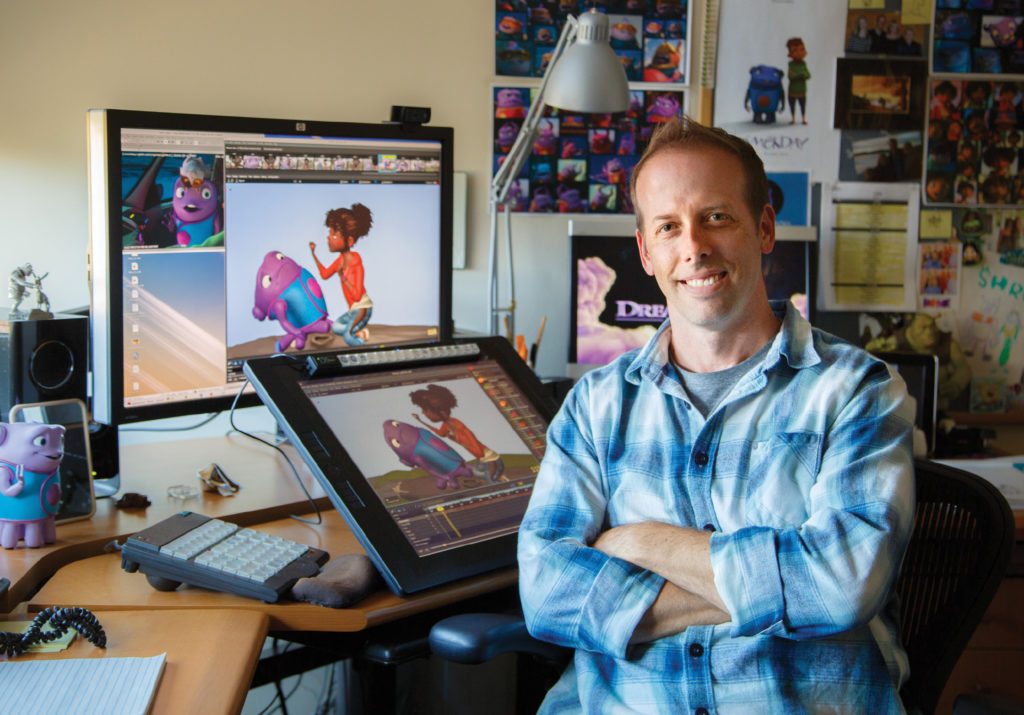 When a kindergarten teacher sends a note home to parents wanting to discuss a drawing their son made in class, it usually leads to an awkward talk about private parts and proper behavior.
When a kindergarten teacher sends a note home to parents wanting to discuss a drawing their son made in class, it usually leads to an awkward talk about private parts and proper behavior.
Such a note arrived for Shelley Aliotti one day nearly 40 years ago, but she already knew enough about her son Jason Reisig’s ar tistic ability not to think the worst. Teacher Kay Goines marveled at the ar twork—a colorful drawing depicting the “Wizard of Oz” cast (Toto, too!) strolling down an intricate yellow brick road. She saw in Jason a prodigy who needed careful nurturing. His mom saw a child having fun and expressing himself—just drawing sunrays and rainbows like any other 5 year old.
“I told her not to be concerned,” says Aliotti, who married John Aliotti when Jason was young (the couple run the Carmel Valley Art Association). “Jason was always an artist. His talent was obvious from pre-school age.”
Reisig, now 44 and living in Los Angeles, parlayed his talent into a successful career in Hollywood at DreamWorks Animation, creators of such animated features as “Shrek,” “How to Train Your Dragon,” “Kung Fu Panda” and the recently released “Home,” starring the voices of Jennifer Lopez and Rihanna. (Facebook photos show Reisig, his wife and their two children posing with Rihanna at the premiere party).
Reisig grew up a curious child who lived in a quaint red farmhouse near Point Lobos before his family settled in Carmel Valley. He loved cowboys and horses, and putting together complicated puzzles (he assembled plastic models before he could even read the instructions), and was fascinated by animation, especially Looney Tunes’ characters.
“I was exposed to all types of art, was always drawing and painting with my mom,” says Reisig, who drew his own 6th birthday party invitation (complete with detailed characters from the Peanuts comic strip) and the baby announcement for the birth of his half-brother Gianni Aliotti.
While attending York School in Monterey, his art education took a giant leap under the tutelage of his aunt, Susan Manchester, a wellrespected artist on the Peninsula. Manchester encouraged Reisig and was instrumental in him putting together a portfolio impressive enough to earn entrance into the prestigious Art Center College of Design in Pasadena, where he majored in illustration.
While studying there in 1993, he earned an internship at Walt Disney Feature Animation in Florida. “They were looking for artists to teach them traditional hand animation,” Reisig says. “I really loved the drawing part of it.” That same year, “Jurassic Park” hit theaters asone of the first movies to successfully meld computer-generated imagery with live action. Two years later, “Toy Story” became the first full-length computer-animated movie.
“Things were changing fast,” Reisig says.
Working at Disney stoked a fire in Reisig. After all, Walt Disney himself created modern animation’s first notable breakthrough with 1928’s “Steamboat Willie,” the first cartoon that included a fully post-produced soundtrack, featuring voice and sound effects printed on the film itself.
With Reisig’s background in fine art, his knowledge of illustration and his lifetime love of animation, he had all the tools to move into the fast-paced, technological world of animated feature films.
Reisig’s career began in 1994 with Alias/Wavefront, a now-defunct software company that produced high-end 3D graphics software. After a few years, he moved to PDI, which was bought out by DreamWorks. After a stint at Sony Pictures Imageworks, Reisig signed on at DreamWorks for a second stint and is now animation department chair.
The first entry on his official filmography is as animator for “Antz” in 1998. He moved on to the Academy Award-winning “Shrek” in 2001 and became lead animator in 2004’s “Spider-Man 2.” In 2006 he became supervising animator on “Over the Hedge,” working on the film with his younger brother Gianni, who followed in Reisig’s footsteps. He supervised a team that brought the characters to life, while Gianni worked on the back end, building the film around the characters. The film cost an estimated $80 million to make, and grossed $155 million worldwide.
The advent of computer and graphic processing hardware has fundamentally changed the animation process—and the quality and vibrancy of the scenes have improved dramatically.
Reisig has led the design and adoption of DreamWork’s NextGen character animation software Premo, giving artists instant access to an unprecedented amount of parallel computer processing power, allowing them to edit characters in full-resolution detail.
“You always fight the complexity issue, what can we do with this and be on time and within resources,” he says. “Now we can manage these crazy characters, like a dragon. We can release those shackles of performance and speed and be able to tell bigger stories with more complex movements.”
Ironically, the new software actually allows for more artistic talent and creativity.
“As professionals we have drawing classes even outside of shop work, trying to always push ourselves,” Reisig says. “It’s a good balance, and very creative. And the lack of pigment and paints and charcoal is OK. I can do that in my spare time.”